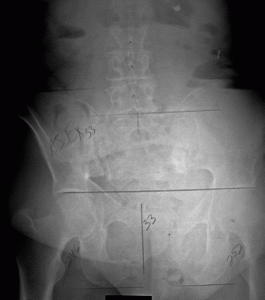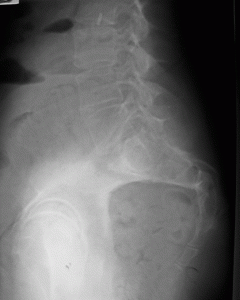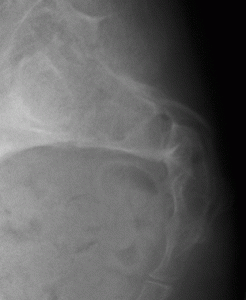Sacral Fracture With Resulting Ilium Subluxation
(From The “G”Note – December 2010)
Case Report
A horizontal or transverse sacral fracture is the most common type of sacral fracture. It usually occurs as a result of a fall upon the buttocks or following direct trauma. The lateral radiograph is usually required to demonstrate the fracture.
A 43-year-old female was presented to our office on November 27, 2010, using a walker to ambulate. During the consultation, she stated that she fell in late July on concrete steps and broke her “tailbone.” Her chief complaint was left lower back pain and left lateral thigh pain. Pain was exacerbated by walking. The physical examination revealed pain and decreased motion on palpation of the left sacroiliac joint. The lumbar spine was free of pain and fixation. Tenderness was noted on the sacrum. The coccyx elicited no discomfort on palpation. The left ilium was deemed the subluxation.
The lateral x-ray revealed a horizontal or transverse fracture of the sacrum around the S-3 level. The AP x-ray demonstrated a sacral fracture and a fracture of the right pubic ramus. The left ilium had an AS6Ex33 listing.
The left ilium subluxation correlated with the patient’s symptoms. The ilium was adjusted on the pelvic bench with the involved side up using a pisiform push move. The patient returned in two days walking without assistance. She stated that she had slept well for the first time in weeks after the adjustment. She had improved but her low back and thigh pain persisted. The same adjustment was given. The patient returned one week later asymptomatic. The ilium was free of subluxation. I was pleased that she had responded to the care so quickly after being in pain for over four months. The patient is now seen on a PRN basis.
Thanks to Dr. Gonstead, results like this are not unusual.
[ED: To the reader, in particular, less experienced chiropractors, one must assess cases such as this very carefully. Do you have the ability to handle a similar case? Are there neurological findings that require extra assessments? When in doubt, get some help.]



